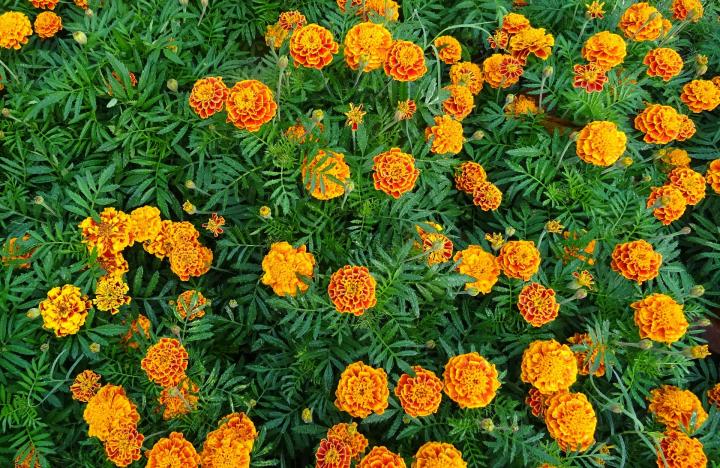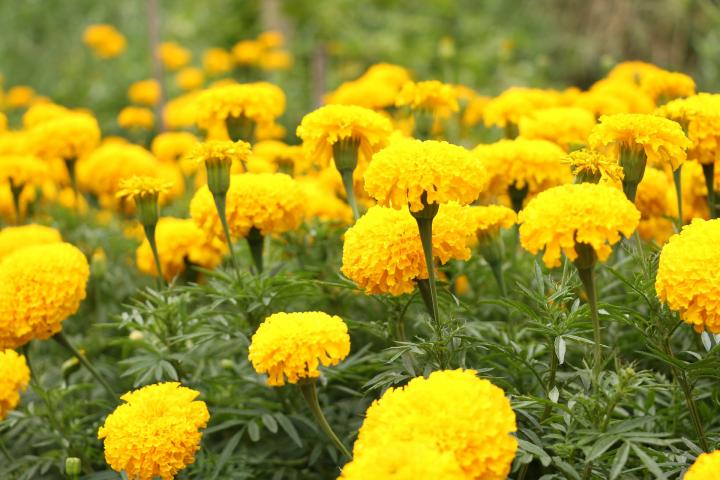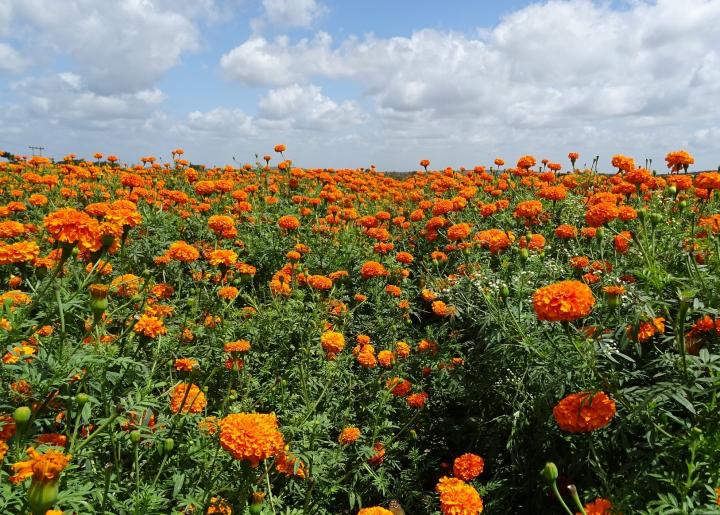
Sunshine on a Stem: Learn Why to Add These Sunny Blooms to Your Garden!
Read Next
Types
Marigolds have been stereotyped, but they offer tremendous variety. Both the American and French marigolds are generally aromatic, too, although some folks find the scent to be a bit overwhelming. Keep that in mind when choosing a planting site.
Marigolds have daisy- or carnation-like flower heads produced singly or in clusters. Although there are some 50 species, most we see in the garden are one of the following:
- Tagetes erecta (aka African marigolds, American marigolds, or Mexican marigolds): This species is the tallest and most upright marigold, reaching 3 to 4 feet in height and producing large, full flowers. According to Nate Dalman of the University of Minnesota Extension, “Despite the names, African marigolds did not originate in Africa; instead they are called that because they were first imported to Europe via a trade route that passed through northwest Africa.” They’re native to Mexico and Central America and will thrive even under drought-like conditions.
- T. patula (aka French marigolds): This species tends to be smaller, bushier, and more compact than T. erecta. They are often wider than they are tall. Elegant and eye-catching, they have relatively demure flowers and usually grow from 6 inches to 2 feet tall. They are better suited to rainier conditions than the other Tagetes species.
- T. tenuifolia (aka signet marigolds): These petite marigolds do well in hot, dry sites and make for a beautiful edging plant. They rarely reach more than a foot in height.
French Marigolds (T. patula)
- ‘Little Hero’ Series: 7-inch-tall plants with large, double carnation flowers in 7 color combinations of maroon, orange, and yellow
- ‘Hero’ Series: 10-inch-tall plants with double carnations, large (2-inch-wide) flowers in 7 different combinations of yellow, orange, and maroon
- ‘Bonanza’ Series: 2-inch-wide, double carnation flowers in 5 different combinations of yellow, orange, and maroon on bushy, compact 8-inch-tall plants
- ‘Aurora’ Series: 1-foot-tall plants with wide-petaled, anemone-like flowers in shades of maroon, yellow, and orange
- ‘Janie’ Series: Early blooming. 8-inch-tall plants are perfect for container growing. Double carnation type flowers in 6 different combinations of yellow, orange, and maroon
- ‘Boy O’ Boy’ Series: 6-inch-tall prolifically flowering plants with flowers in shades of maroon, yellow, and orange

American/African Marigolds (T. erecta)
- ‘Jubilee’ Series: 2-foot-tall plants with dense, double flowers in shades of yellow and orange
- ‘Gold Coin’ Series: 1½- to 2-foot-tall plants with large (5-inch-wide) double blooms in gold, yellow, and orange
- ‘Safari’ Series: 1-foot-tall plants with flat-topped, large flowers in shades of maroon, yellow, and orange
- ‘French Vanilla’: 3-inch-wide flowers are pure creamy white; minimal scent; 1½ to 2 feet tall
Where to Buy Marigolds
Gardening Products
Hi Mike,
It's great that you were able to give those emerging marigolds the boost they needed to make it through the season.
Outside of a few shrub varieties, marigolds are an annual flower that die back completely at the end of each season once the frost sets in. So you would not prune them, but rather remove the entire plant because it will not come back the following year.
What you likely cared for were the plants that came from the seeds from last year's plants. If marigolds are not deadheaded, they will readily self-seed the area and plants can/will grow the following year. If you did not deadhead this year as blooms began to fade, there is a chance that seeds fell to the soil once the pods dried and opened, meaning there will hopefully be marigold plants in that same area next season. If not, you can always plant new transplants in the spring once the threat of frost has passed.
Hope this helps!
Hi, Linda. After your marigolds have had their "day in the sun," you can cut them up into pieces and work them back into the soil. The thinking is that it helps to control pests that may lurk in the soil for the next growing season. But adding them to your compost pile is also a good place for them.
Hi Karen,
Instead of deadheading your marigolds, let spent flowers remain on the plant to dry. As the seed head matures, it will turn brown. To catch seeds you can place a paper bag underneath the spent blooms, but it is not always necessary. Once the seed pod is dry, remove them from the plant and allow to air dry for a few days. Then you can harvest the seeds from the pod and put in an envelope until you are ready to plant in the spring.
- « Previous
- 1
- 2
- …
- 10
- Next »












Comments